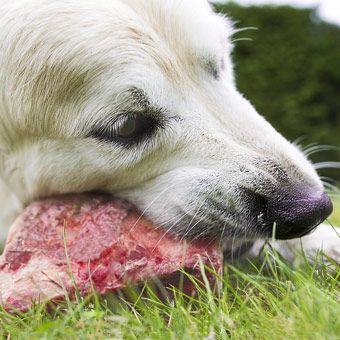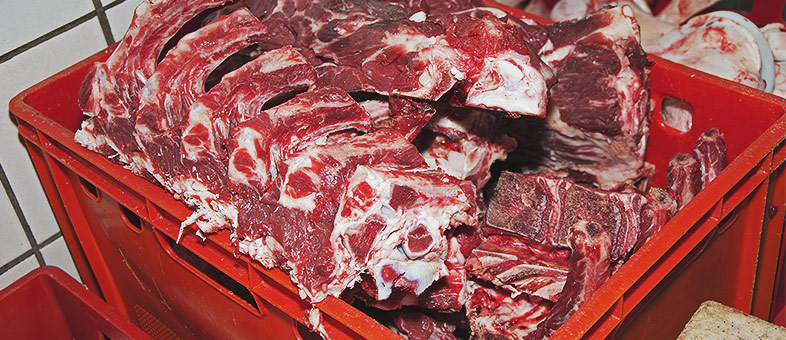
Test BARF and Fleischsaftgarung – similarities and differences
“Raw meat feeding is the most species-appropriate and therefore healthiest way to feed a dog.” This sounds understandable, since the dog is descended from the wolf. According to a genetic study conducted in 2002, the origin of the domestic dog is believed to be about 15,000 years ago (https://pubmed.ncbi.nlm.nih.gov/12446907). Therefore, we can share our four walls amicably with today's generation of dogs. Even with a hand-raised wolf, this would not be possible. But how has the need for food changed over the generations?
Even a quick glance at the dog's dentition reveals fang and carnassial teeth. The dentition of an herbivore looks clearly different. It is the same with the digestive organs, which remained unchanged during the transformation from wolf to dog. Furthermore, the dog thus has the dentures and the digestive organs of a carnivore. However, our small comparison of the food needs of wolf and dog has a catch: The dog does not hunt its breakfast! He receives his food regularly and without his intervention.
BARFed like a wolf?
Going back to nature without living in nature is as contradictory as it sounds. A large part of the wolf's life is taken up with the procurement of food. Nature is not always helpful in this. Snow and drought make hunting difficult. In optimal conditions, the wolf hunts only with limited success. Only about ten percent of its hunting attempts lead to a meal (https://chwolf.org/woelfe-kennenlernen/biologie-ethologie/jagd-und-fressverhalten). Therefore, the wolf often must starve, not infrequently for several days. To bridge the time until the next hunting success, he likes to fill his belly with up to 20 percent of his body weight (in the comparison, BARFed dogs receive only two to three per cent of their body weight). Thus, the wolf's natural diet is not meat alone. Rather, it is a combination of starvation for days, great effort, and finally eating a large amount of meat. We reduce the concept of wolf nutrition to the regular feeding of an agreed amount of meat and call it "species-appropriate raw feeding".
The simulation of a prey animal for our dog
The prey animal consists of more than meat. Therefore, for a BARF food, we need not only protein but also carbohydrates, fats, minerals and vitamins. For the proper simulation of a prey animal, each individual component may only make up a certain amount of the food. If this works, we have a balanced BARF food for our dog.
We think that should not be a problem; after all, there are already ready-made mixtures of fruits and vegetables, fruits, minerals and herbs in specialized stores. Bone meal, eggshell powder and cold-pressed oil can also be purchased there. For the very painless BARFer, we even found beef and lamb blood, bottled in small glass vials.
Now for the composition of the natural and healthy BARF food, the beauty of doing it yourself: You know what goes into the food! But do you really know this when using ready-made mixtures of fruits and vegetables, minerals and herbs? Where does the BARF meat actually come from, and is it hygienically safe? In any case, the declarations of most dry and wet foods are not checked either.
We start to defrost the meat in the refrigerator. Meanwhile, we put the electronic scale and get the BARF recipe from the Internet ready. After the meat is thawed and we have set up all the ingredients for a balanced diet around the scale, we start weighing the individual food components accurately. If possible, we should not make mistakes when weighing the food components , because Prof. Dr. med. vet. Jürgen Zentek, Director of the Institute for Animal Nutrition at the Free University of Berlin/Germany, says, "One problem with preparing your own mix is the fluctuating nutrient content of the individual components, so the feed may have varying nutrient content. A balanced formula that meets requirements is a prerequisite for keeping the animal healthy in the long term."
So the individual food components cannot be determined by feel, and tasting is also not possible, for that the innards stink too much. To prepare each dog meal fresh in this way is quite time-consuming, so we take a morning and prepare BARF meals for the next 14 days, which we then freeze.
Actually, we could then buy frozen ready BARF meals right away. This saves us the search, purchase and timely reordering of each BARF component, the exact weighing, freezing and of course, we do not need to worry about a balanced recipe. This is done for us by experts who ensure a balanced recipe that meets our dogs needs without fluctuating nutrient content.

Ready-made BARF menus
We think that ready-made BARF menu couldn't be better, but then we google and come across the magazine 06/2019 of Stiftung Warentest, a German foundation and independent consumer organization. In this issue of the magazine, among other things, the test results of ready BARF menus are published. A conclusion from the test: "Ready-made BARF menus do not come close to the balance of many canned foods, as our test shows." (https://www.test.de/Nassfutter-Hund-Test-4817396-4819621)
Dibo – Menu of beef, heart, cereals and vegetables.
"Lacking countless nutrients: ... far too little potassium, vitamins A and D – and too little protein." "Significantly contaminated with enterobacteria."*.
Petman – Barf-in-One Complete Menu Horse
"... Far too little selenium, too little potassium, calcium, and phosphorus."*
Procani – Procani – Beef Complete Menu
"... Linoleic acid comes but much too short, as well as vitamins B1, D, and E." "Highest load of E. coli bacteria in the test."*.
Tackenberg – BARF menu of horse with heath potatoes
"... Too little vitamin A and D, calcium, copper, selenium, iodine. Very clearly contaminated with enterobacteria."*.
ZooRoyal – Hector & Paula Huhn Komplett-Menü
"... Too little vitamin A and B1, too little copper, but six times the calcium requirement." "Clearly germ-contaminated."*.
* Source: Stiftung Warentest 06/2019
We find the bacterial load of the meat of almost all suppliers of ready-made BARF menus mentioned here disturbing.
Stiftung Warentest advises, "In households where immunocompromised people, seniors, pregnant women or small children live, animals should not get raw meat. It may contain disease-causing germs that are transmissible to humans."
Source: https://www.test.de/Nassfutter-Hund-Test-4817396-4819621
In a study conducted by the University of Zurich in 2019, ready-made BARF menus were tested for multi-resistant bacteria. The result is frightening. Multi-resistant bacteria were found in every second BARF menu.
Source: https://www.media.uzh.ch/de/medienmitteilungen/2019/Barfen-Futter.html

BARF has a hygiene problem
Conclusions on BARF: The bacterial load of BARF meat makes us realise why we boil fresh meat, and it eliminates our desire for BARF. BARF is a captivating feeding concept, which, however, can only be implemented with a great deal of effort, because there is obviously no easy way to BARF with ready-made BARF meals.
Stiftung Warentest advises an individual dog nutrition plan, prepared by a qualified veterinarian, and uses an example to show how complicated a proper BARF recipe looks: "A model dog that weighs 15 kilos, is moderately active and needs 724 kilocalories a day. A daily portion of BARF would look like this for him: 140 grams of beef muscle meat (8 percent fat), 45 grams of green beef rumen, 50 grams of beef kidney, 10 grams of chicken necks, 20 grams of lean cottage cheese, 40 grams of unmineralised oatmeal, 50 grams each of carrots, zucchini, apples and banana, 10 grams of sunflower oil, 5 grams of salmon oil, 2 grams of eggshell powder (containing 39 percent calcium, 1 percent phosphorus), one tablet of 25 milligrams of zinc and 1.5 milligrams of copper, 2.25 tablets of 100 micrograms of iodine, 2 grams of cod liver oil (containing 110 000 I. E. vitamin A and 8 100 I.E. vitamin D per 100 grams)."
Source: https://www.test.de/Nassfutter-Hund-Test-4817396-4819621
Fleischsaftgarung, the BARF alternative
We wanted to BARF with pleasure, but there is the effort and the risk of getting sick from bacteria ourselves. As a real alternative to BARF, we have identified the Fleischsaftgarung. Why?
Dog food prepared with Fleischsaftgarung is regularly tested for enterobacteria and E. coli bacteria by the German TÜV, one of the most renowned testing laboratories in Germany. Enterobacteria and E. coli bacteria are the bacteria found by Stiftung Warentest in some ready-made BARF meals (see above).
Further tests of dog food prepared with Fleischsaftgarung by the German TÜV check for the following:
- whether the advertised fresh meat content is actually used in the preparation,
- if the declaration is correct and
- whether it is safe with regard to the following:
- Heavy metals (arsenic, lead, mercury and cadmium),
- Mycotoxins (aflatoxin B, G and ochratoxin),
- germs and bacteria (Salmonella, presumptive Bacillus cereus, Clostridium perfringens and Staphylococcus) and
- Microorganisms (yeasts and molds).
This does not exist in any other preparation process of dog food. The regular and independent testing of dog food prepared with Fleischsaftgarung by one of the most renowned testing laboratories in Germany gives us a good feeling of security after the shock of the many BARF menus contaminated with germs and bacteria. Additionally, we know by the examination that the meat proteins actually come from fresh meat and not from meat meals.
Similarities of BARF and Fleischsaftgarung
The largest similarity between the BARF and Fleischsaftgarung methods is the use of fresh meat.
Both dog owners who feed their dog with BARF and dog owners who prefer dog food prepared with Fleischsaftgarung see their dogs as carnivores that must be fed primarily with nutrient-rich fresh meat in order to keep them healthy in the long term.
Another major commonality between the two groups is their reliance on ingredients. The self-preparing BARFer knows what ingredients are being used. On the other hand, the Fleischsaftgarer knows that the declared ingredients are actually contained in the dog food, because this is regularly checked by one of the most renowned testing laboratories in Germany.
Further similarities of BARF and Fleischsaftgarung are the high nutrient content, the high pleasure for the dog and the high digestibility. This is where the similarities end. While the BARFer sees and feeds the predator in his dog, the Fleischsaftgarer has taken his dog into the closest circle of the family and feeds him food that is at the same level of his own food.
Fleischsaftgarung is a method of preparation of human food
The history of Fleischsaftgarung is quite exciting. It can be read that Fleischsaftgarung did not originate in the feed industry but in the kitchen. It was probably preceded by the desire to prepare dog food like human food, because the dog's habitat is the family. After all, you don't want to make your best friend worse off.

Fleischsaftgarung results in equivalent food, but it is tailored to the needs of the dog.
For this, one has started at the very top of human food and oriented to selected methods of top chefs who prepare meat tastier and also healthier through the meat juice. The whole thing was then adapted to suit dogs. This is how Fleischsaftgarung came into being, a method of preparing dog food at the level of human food.
BARF is like the Fleischsaftgarung – a life attitude
BARF is directed to the past. The imitated prey animal is brought to the dog without the successful hunt, and the efforts connected with it only result in a tasty meal. The dog does not live what BARF promises, a natural diet.
Fleischsaftgarung, on the other hand, is focused on the here and now. There is no attempt to pretend that the dog has the opportunity to experience food like a wolf. Fleischsaftgarer have accepted that the dog can no longer live the life of a wolf, and they see the dog's simultaneous well-being in various areas of life as the only honest path to lasting health. They treat their dog as a best friend, an equal member of the family, and therefore, they feed it at their level.

A good best friend
Conclusion BARF and Fleischsaftgarung
BARF and Fleischsaftgarung are more than healthy dog food.
With its orientation on the eating habits of wolves, BARF embodies the desire to give the dog back a part of its origin, which has been lost to it through domestication. Unfortunately, this is a notion that is far from reality. The dog has adapted to humans so strongly in the last 15,000 years that there is no going back. What remains of the BARF idea is a tasty and healthy food for the dog, especially because it is based on meat that corresponds to the dog's nature. As we had to find out, BARF is associated with a lot of effort, and ready-made BARF meals are rather inadvisable because of the germ and bacteria load. The germ load and bacteria load are less of a problem for the dog than for the human. It is possible that the dog owner can become ill by BARFing his dog.
Compared to BARF, Fleischsaftgarung is focused on the here and now. Thus, dog food prepared with Fleischsaftgarung is a part of the health-related quality of life of the dog. This goes beyond the physical well-being and includes the mental condition and the social situation of the dog. Accordingly, health is achieved when the dog is not worse off in any area of life than the other members of the family.
From our point of view, the concept of Fleischsaftgarung follows a more holistic understanding of dog health than the BARF idea. Today, the dog can be an equal member of the family but can no longer lead a life in freedom. The prey animal elaborately simulated by the dog owner in the kitchen does not really fulfill the dog’s needs because he has not hunted it himself. It remains only a substitute for freedom.
Fleischsaftgarung has no germ and bacteria pollution, and additionally, its shelf life is much longer compared to BARF. The regular examination of the Fleischsaftgarung ingredients by one of the most renowned test centres of Germany ensures transparency, guarantees the correctness of the ingredients as well as quantities and protects the health of the dog and its owner.
Pros and cons
| Questions | BARF | Fleischsaftgarung |
| Fresh meat | Fresh meat | Fresh meat |
| Bacteria and germs | possible | no, is monitored by TÜV, one of the most renowned testing laboratories in Germany |
| Ingredients | transparent in case of self-preparation | transparency through testing and confirmation |
| Balanced formular | to meet requirements best prepared by a qualified veterinarian | required by law |
|
Fluctuating nutrient content |
no, if everything is weighed correctly | no, as checked by TÜV |
| Nutrient content | very high | very high |
| Enjoyment | maximum, because it's meat | maximum, because it's meat |
| digestibility | high, because of meat | high, because of meat |
| Tartar formation | low, since hardly any carbohydrates | low, since hardly any carbohydrates |
| Risk of obesity | low, since hardly any carbohydrates | low, since hardly any carbohydrates |
| Availability | online and specialized trade | online and specialized trade |

